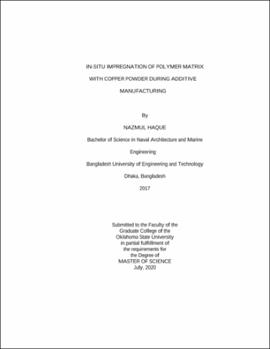| dc.contributor.advisor | Noori, Hadi | |
| dc.contributor.author | Haque, Nazmul | |
| dc.date.accessioned | 2021-02-22T22:41:12Z | |
| dc.date.available | 2021-02-22T22:41:12Z | |
| dc.date.issued | 2020-07 | |
| dc.identifier.uri | https://hdl.handle.net/11244/328647 | |
| dc.description.abstract | The fillers are used to increase the functional properties of polymer matrix composites (PMCs). Additive manufacturing can be potentially used to tailor the PMCs' properties through customization of the spatial architecture of fillers (heterogeneous phases). In this study, a novel additive processing of PLA-copper composite is introduced. The fused deposition modeling (FDM) process was utilized as a platform to customize the spatial architecture of copper fillers in the 3-D structure of the PLA matrix. Prior to the extrusion process in FDM, the grooves were made on the surface of PLA filament by the knurling process. Based on the final design requirements, selected grooves were filled with copper powders. The copper powders were emulsified into liquid starch before introducing them to the groove regions. The geometry of the grooves, the interval between them, and the size/type of the powders can be independently changed to control the amount/distribution and size/type of the fillers in the final PMC product. Monolayer samples were manufactured layer by layer with a layer height and width of 0.6 and 25 mm, respectively. The PMC was devised to have a 20 mm length at the middle of samples with 90 mm length. After printing, the samples were treated with 3 kW microwave exposure for 30, 60, 75, and 90 seconds. Both treated and non-treated samples were subjected to uniaxial tensile tests to assess their fracture energy. For all samples, the fracture was brittle at the interface between the layers. The samples with PMC sections showed inferior fracture strength in comparison with pure PLA samples. This result was attributed to the presence of imperfections (voids and micro-cracks) at the interlayer areas. The microwave treatment for 75s significantly improved the fracture energy of composites. The microwave heating helped in enhancing the interlayer bond strength through the interaction with copper particles. Different mechanisms are suggested to explain this improvement. Further studies are required to assess the mechanisms. | |
| dc.format | application/pdf | |
| dc.language | en_US | |
| dc.rights | Copyright is held by the author who has granted the Oklahoma State University Library the non-exclusive right to share this material in its institutional repository. Contact Digital Library Services at lib-dls@okstate.edu or 405-744-9161 for the permission policy on the use, reproduction or distribution of this material. | |
| dc.title | In-situ impregnation of polymer matrix with copper powder during additive manufacturing | |
| dc.contributor.committeeMember | Harimkar, Sandip P. | |
| dc.contributor.committeeMember | Wang, Shuodao | |
| osu.filename | Haque_okstate_0664M_16873.pdf | |
| osu.accesstype | Open Access | |
| dc.type.genre | Thesis | |
| dc.type.material | Text | |
| thesis.degree.discipline | Mechanical and Aerospace Engineering | |
| thesis.degree.grantor | Oklahoma State University | |
